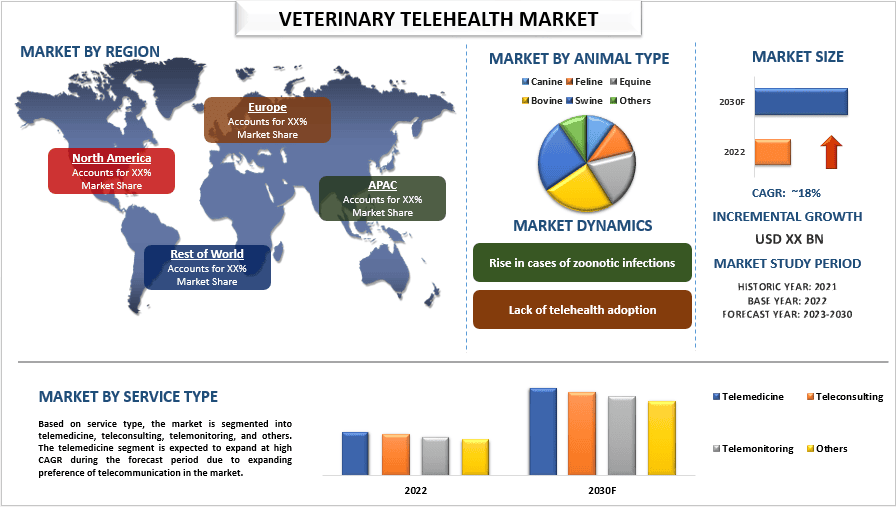- Home
- About Us
- Industry
- Services
- Reading
- Contact Us
Veterinary Telehealth Market: Current Analysis and Forecast (2023-2030)
Emphasis on Animal Type (Canine, Feline, Equine, Bovine, Swine and Others); Service Type (Telemedicine, Teleconsulting, Telemonitoring and Others); and Region/Country

According to a new report by Univdatos Market Insights, Veterinary Telehealth Market is expected to reach USD 450 Million in 2030 by growing at a CAGR of 18%. Many factors were identified which helped in propelling the market in the forecast period such as the surge in chronic illnesses in animals. Other factors such as increasing pet ownership, and obesity in canines which are potentially causing diabetes, blood-pressure-related disorders, renal illness, and spinal disc disorders are also driving the growth of the market. Veterinary Telehealth services gained prominence post-COVID-19, the reason being the dependency of people to get consultations from remote areas. In addition to this, investments in pet healthcare have increased significantly in recent years, which is one of the key factors that are creating opportunities for the market. For instance, the American Pet Products Association (APPA), reported that the U.S. spent USD 103.6 billion on pets in the year 2020 and it is predicted that USD 109.6 billion will be spent on pets in the U.S. in 2021.
TeleTails; Activ4Pets; BabelBark, Inc.; FirstVet, Inc.; TeleVet; Vetster, Inc.; VitusVet; airVet, Inc.; PawSquad; GuardianVets, Inc. are some of the key players in the market. Several M&As along with partnerships have been undertaken by these players to facilitate customers with hi-tech and innovative products/technologies.
Insights Presented in the Report
“Amongst animal type, feline category to witness higher CAGR during the forecast period”
Based on animal type, the market is segmented into canine, feline, equine, bovine, swine, and others. The feline segment is expected to grow with a high CAGR during the forecast period as taking care of felines (cats) is easier than taking care of canines (dogs). In February 2023, the World Animal Foundation confirmed that nearly 43% of cats were adopted from animal shelters in the year 2022, while this percentage was quite lesser for dogs i.e., 40. BMC Veterinary Research also reported in 2023 that there were higher adoption rates of cats than dogs.
“Amongst service type, telemedicine to grow with a significant share in the market in 2022”
Based on service type, the market is categorized into telemedicine, teleconsulting, telemonitoring, and others. The telemedicine segment is expected to hold a significant share of the market in 2022 owing to the ease of getting consultations from a vet specialist through modified apps. There are multiple offerings by virtual telemedicine set-up, they offer vet care in various formats- text, call, or video where a veterinarian can visualize the health status of a pet and can give consultations sitting far away from the patient. That way pets get their ailments noticed even in non-emergency situations. Likewise, VCA Animal Hospitals in U.S. and Canada, have added video consultations to their list of offerings. Also, Dutch which is a virtual veterinarian care platform based in San Francisco launched a pet care platform in July 2021 and happened to raise 20 million dollars to extend its telemedicine platform for pets.
“Amongst regions, APAC to grow with a significant rate in the market in forecast period”
APAC to hold a significant share of the global veterinary telehealth market in the forecast period. Several factors such as a surge in the development of a wide range of applications of veterinary telehealth technology, enhanced accessibility, and minimum healthcare costs through online consultations are driving the market’s growth during the forecast period. Further, the increase in incidences of chronic diseases in pets in the region is also having a positive impact on the market’s growth. There have been significant improvisations and enhancements in veterinary telehealth in the region. For instance, in July 2021, Singapore-based company- ZumVet launched its telehealth platform in Hong Kong which is a remote care solution for wellness of pets. Such innovations seem promising in the growth of the veterinary telehealth market in the APAC region.
Reasons to buy this report:
- The study includes market sizing and forecasting analysis validated by authenticated key industry experts.
- The report presents a quick review of overall industry performance at one glance.
- The report covers an in-depth analysis of prominent industry peers with a primary focus on key business financials, product portfolio, expansion strategies, and recent developments.
- Detailed examination of drivers, restraints, key trends, and opportunities prevailing in the industry.
- The study comprehensively covers the market across different segments.
- Deep dive regional level analysis of the industry.
Customization Options:
The global veterinary telehealth market can further be customized as per the requirement or any other market segment. Besides this, UMI understands that you may have your own business needs, hence feel free to connect with us to get a report that completely suits your requirements.
Table of Content
Research Methodology for the Veterinary Telehealth Market Analysis (2023-2030)
Analyzing the historical market, estimating the current market, and forecasting the future market of the global veterinary telehealth market were the three major steps undertaken to create and analyze the adoption of veterinary telehealth in major regions globally. Exhaustive secondary research was conducted to collect the historical market numbers and estimate the current market size. Secondly, to validate these insights, numerous findings and assumptions were taken into consideration. Moreover, exhaustive primary interviews were also conducted, with industry experts across the value chain of the global veterinary telehealth market. Post assumption and validation of market numbers through primary interviews, we employed a top-down/bottom-up approach to forecasting the complete market size. Thereafter, market breakdown and data triangulation methods were adopted to estimate and analyze the market size of segments and sub-segments of the industry pertains to. Detailed methodology is explained below:
Analysis of Historical Market Size
Step 1: In-Depth Study of Secondary Sources:
Detail secondary study was conducted to obtain the historical market size of the veterinary telehealth market through company internal sources such as annual reports & financial statements, performance presentations, press releases, etc., and external sources including journals, news & articles, government publications, competitor publications, sector reports, third-party database, and other credible publications.
Step 2: Market Segmentation:
After obtaining the historical market size of the veterinary telehealth market, we conducted a detailed secondary analysis to gather historical market insights and share for different segments & sub-segments for major regions. Major segments are included in the report as animal type, service type, and regions. Further country-level analyses were conducted to evaluate the overall adoption of testing models in that region.
Step 3: Factor Analysis:
After acquiring the historical market size of different segments and sub-segments, we conducted a detailed factor analysis to estimate the current market size of the veterinary telehealth market. Further, we conducted factor analysis using dependent and independent variables such as animal type, service type, and regions of veterinary telehealth. A thorough analysis was conducted for demand and supply-side scenarios considering top partnerships, mergers and acquisitions, business expansion, and product launches in the veterinary telehealth market sector across the globe.
Current Market Size Estimate & Forecast
Current Market Sizing: Based on actionable insights from the above 3 steps, we arrived at the current market size, key players in the global veterinary telehealth market, and market shares of the segments. All the required percentage shares split, and market breakdowns were determined using the above-mentioned secondary approach and were verified through primary interviews.
Estimation & Forecasting: For market estimation and forecast, weights were assigned to different factors including drivers & trends, restraints, and opportunities available for the stakeholders. After analyzing these factors, relevant forecasting techniques i.e., the top-down/bottom-up approach were applied to arrive at the market forecast for 2030 00for different segments and sub-segments across the major markets globally. The research methodology adopted to estimate the market size encompasses:
- The industry’s market size, in terms of revenue (USD) and the adoption rate of the veterinary telehealth market across the major markets domestically
- All percentage shares, splits, and breakdowns of market segments and sub-segments
- Key players in the global veterinary telehealth market in terms of products offered. Also, the growth strategies adopted by these players to compete in the fast-growing market
Market Size and Share Validation
Primary Research: In-depth interviews were conducted with the Key Opinion Leaders (KOLs) including Top Level Executives (CXO/VPs, Sales Head, Marketing Head, Operational Head, Regional Head, Country Head, etc.) across major regions. Primary research findings were then summarized, and statistical analysis was performed to prove the stated hypothesis. Inputs from primary research were consolidated with secondary findings, hence turning information into actionable insights.
Split of Primary Participants in Different Regions

Market Engineering
The data triangulation technique was employed to complete the overall market estimation and to arrive at precise statistical numbers for each segment and sub-segment of the global veterinary telehealth market. Data was split into several segments & sub-segments post studying various parameters and trends in the areas of animal type, service type, and regions in the global veterinary telehealth market.
The main objective of the Global Veterinary Telehealth Market Study
The current & future market trends of the global veterinary telehealth market were pinpointed in the study. Investors can gain strategic insights to base their discretion for investments on the qualitative and quantitative analysis performed in the study. Current and future market trends determined the overall attractiveness of the market at a regional level, providing a platform for the industrial participant to exploit the untapped market to benefit from a first-mover advantage. Other quantitative goals of the studies include:
- Analyze the current and forecast market size of the veterinary telehealth market in terms of value (USD). Also, analyze the current and forecast market size of different segments and sub-segments
- Segments in the study include areas of animal type, service type, and regions
- Define and analysis of the regulatory framework for the veterinary telehealth industry.
- Analyze the value chain involved with the presence of various intermediaries, along with analyzing customer and competitor behaviors of the industry.
- Analyze the current and forecast market size of the veterinary telehealth market for the major region.
- Major countries of regions studied in the report include Asia Pacific, Europe, North America, and the Rest of the World.
- Company profiles of the veterinary telehealth market and the growth strategies adopted by the market players to sustain in the fast-growing market
- Deep dive regional level analysis of the industry
Related Reports
Customers who bought this item also bought










